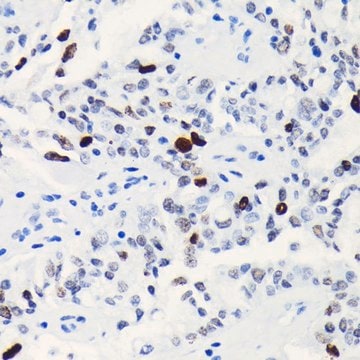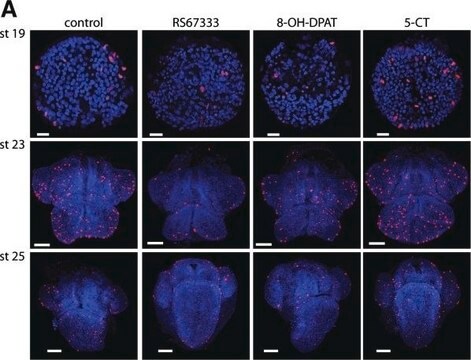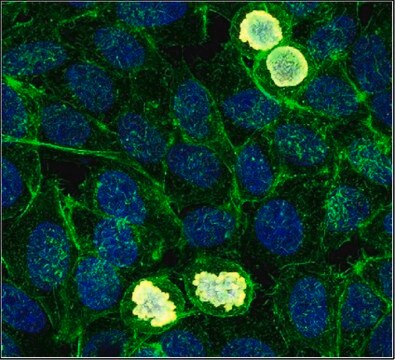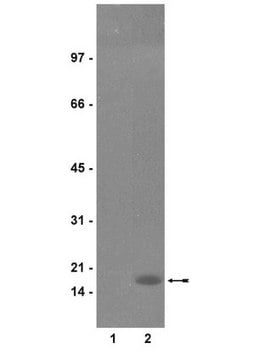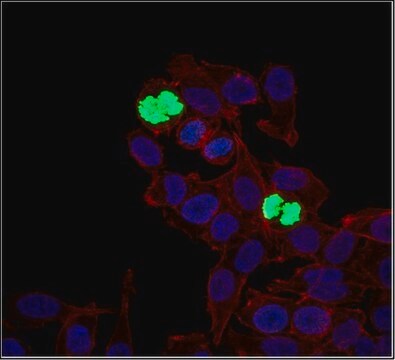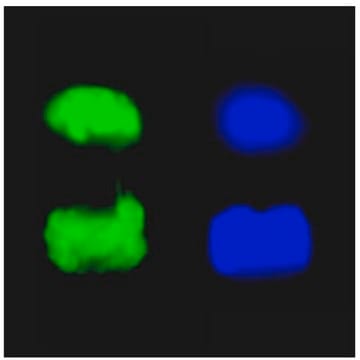05-806
Anti-phospho-Histone H3 (Ser10) Antibody, clone 3H10
clone 3H10, Upstate®, from mouse
Synonim(y):
H3 histone, family 3A, H3S10P, Histone H3 (phospho S10), H3 histone, family 3A, H3 histone, family 3B, H3 histone, family 3B (H3.3B)
About This Item
Polecane produkty
pochodzenie biologiczne
mouse
Poziom jakości
forma przeciwciała
purified immunoglobulin
rodzaj przeciwciała
primary antibodies
klon
3H10, monoclonal
reaktywność gatunkowa
human
producent / nazwa handlowa
Upstate®
metody
flow cytometry: suitable
immunocytochemistry: suitable
immunofluorescence: suitable
inhibition assay: suitable (peptide)
multiplexing: suitable
western blot: suitable
izotyp
IgG1κ
numer dostępu NCBI
numer dostępu UniProt
Warunki transportu
wet ice
docelowa modyfikacja potranslacyjna
phosphorylation (pSer10)
informacje o genach
human ... HIST1H3F(8968)
Powiązane kategorie
Opis ogólny
Specyficzność
Zastosowanie
This antibody has been reported by an independent laboratory to detect phosphorylated histone H3 using flow cytometry.
Beadlyte Histone-Peptide Specificity Assay:
1:1,000 to 1:81,000 dilutions of a previous lot were incubated with histone H3 peptides containing various modifications conjugated to Luminex microspheres. (Figure B). Only the peptide containing phospho-serine 10 was detected.
Immunocytochemistry:
0.2 μg/mL of a previous lot showed positive chromosome immunostaining for mitotic A431 and HeLa cells fixed with 95% ethanol and 5% acetic acid and permeabilized with 0.1% Triton X-100.
Peptide Inhibition Analysis:
Detection of histone H3 in immunoblots of colcemid treated HeLa acid extracts by anti-phospho-Histone H3 (Ser10) was diminished by 10 μM of histone H3 peptide containing phospho-serine 10, but not by peptides containing phospho-serine 28 or an unmodified histone H3 sequence (Figure C).
Immunofluorescence:
Jakość
Western Blot Analysis:
0.05-0.5 μg/mL of this lot detected phosphorylated histone H3 in acid extracted proteins from mitotic HeLa cells treated with colcemid (Catalog # 17-306), but not unmodified recombinant Histone H3 (Catalog # 14-494) (Figure A).
Opis wartości docelowych
Postać fizyczna
Przechowywanie i stabilność
Handling Recommendations:
Upon receipt, and prior to removing the cap, centrifuge the vial and gently mix the solution. Aliquot into microcentrifuge tubes and store at -20°C. Avoid repeated freeze/thaw cycles, which may damage IgG and affect product performance. Note: Variability in freezer temperatures below -20°C may cause glycerol containing solutions to become frozen during storage.
Komentarz do analizy
UV-treated 293 cell extracts, UV-treated HeLa cell extracts, breast cancer tissue, HEPG2 cell extracts.
Inne uwagi
Informacje prawne
Not finding the right product?
Try our Narzędzie selektora produktów.
polecane
Kod klasy składowania
12 - Non Combustible Liquids
Klasa zagrożenia wodnego (WGK)
WGK 1
Temperatura zapłonu (°F)
Not applicable
Temperatura zapłonu (°C)
Not applicable
Certyfikaty analizy (CoA)
Poszukaj Certyfikaty analizy (CoA), wpisując numer partii/serii produktów. Numery serii i partii można znaleźć na etykiecie produktu po słowach „seria” lub „partia”.
Masz już ten produkt?
Dokumenty związane z niedawno zakupionymi produktami zostały zamieszczone w Bibliotece dokumentów.
Nasz zespół naukowców ma doświadczenie we wszystkich obszarach badań, w tym w naukach przyrodniczych, materiałoznawstwie, syntezie chemicznej, chromatografii, analityce i wielu innych dziedzinach.
Skontaktuj się z zespołem ds. pomocy technicznej


